Nylon, a synthetic polyamide material, is renowned for its high strength, durability, and versatility. Since its development by DuPont in 1935, nylon has become integral to modern industry and daily life, from stockings to automotive parts and medical devices, underscoring nylon’s significance and broad scope across multiple fields.
This article aims to systematically introduce various types of nylon materials, including common types such as Nylon 6, Nylon 66, Nylon 11, Nylon 12, and their modified forms, analyzing their chemical structures, performance characteristics, and application areas, to help readers comprehensively understand the diversity of this important material and its critical role in modern technology.
Basic Overview Of Nylon
Nylon is a family of synthetic polymers known as linear polyamides, characterized by repeating units linked through amide bonds.
This silk-like thermoplastic is typically derived from petroleum and can be melt-processed into fibers, films, or molded shapes. Additionally, nylon polymers can be combined with various additives or blended with other fibers to create nylon blends, tailoring fabric properties for diverse applications.
Nylon’s journey began in 1931, when Wallace Carothers, an organic chemist at DuPont, succeeded in creating the first synthetic fiber designed to replace silk. This breakthrough was the result of extensive research aimed at finding a cost-effective and durable alternative to natural fibers.
Nylon made its public debut at the New York World’s Fair in 1939, where it was showcased as the material for women’s stockings, quickly gaining popularity for its silk-like feel and superior durability.
During World War II, the demand for nylon increased dramatically as it was used in a wide range of industrial applications, including nylon parachute material, truck tires, tents, and fuel tanks, effectively replacing silk in many critical uses.
After the war, nylon’s production continued to expand, and it became a staple material in both clothing and industrial products, solidifying its place as a revolutionary synthetic fiber in modern manufacturing.
Nylon fabric is a key example of its use in clothing and textiles, valued for its durability and versatility. From nylon fabrics in clothing to lightweight components in automobiles and high-performance materials in medical devices, nylon’s versatility makes it an indispensable material.
Nylon belongs to the broader family of PA material, which includes PA 12 and other polyamides used in 3D printing and various industrial applications.
Its lightweight, high-strength properties drive industrial lightweighting trends, while nylon’s durability and moldability meet diverse needs in daily life.
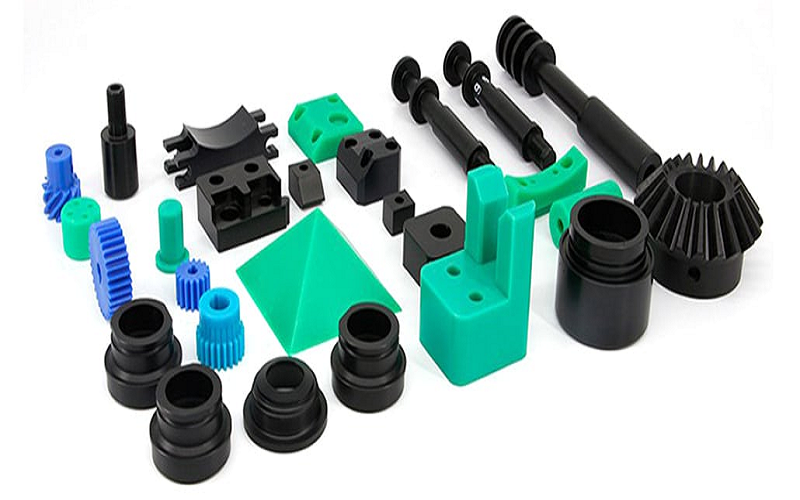
How Is Nylon Made?
The production of nylon involves a chemical process known as polymerization, where diamines and dicarboxylic acids react to form long chains of repeating units.
This process results in a polymer that can be melt processed into fibers, films, or molded parts with specific properties tailored to the intended application.
For instance, nylon 6 is produced through the thermal polymerization of caprolactam, while nylon 6,6 is synthesized by reacting adipic acid with hexamethylenediamine.
These different production methods not only influence the properties of the final nylon material but also affect production costs and scalability.
By adjusting the manufacturing process, manufacturers can create nylon types with unique characteristics, such as enhanced strength, flexibility, or chemical resistance, ensuring the right fit for a wide range of uses.
Properties of Nylon
Nylon is renowned for its superior strength, durability, and excellent chemical resistance, making it a preferred material for a wide array of consumer goods and industrial applications.
One of nylon’s standout features is its high melting point, which allows it to perform reliably in high-temperature environments. Its mechanical properties, such as high tensile strength and elasticity, enable nylon to withstand wear and maintain its shape under stress.
However, nylon can absorb moisture from the environment, which may impact its dimensional stability and mechanical properties over time.
The degree of moisture absorption and chemical resistance can vary between different types of nylon, such as nylon 6 and nylon 6,6, with each offering distinct advantages depending on the application.
Overall, nylon’s combination of durability, high melting point, and resistance to many chemicals makes it a valuable material across numerous industries.
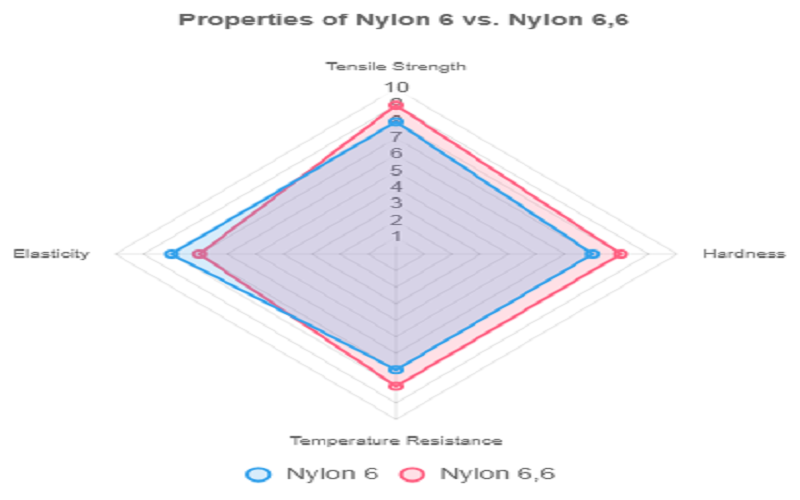
Common Types Of Nylon
Here are some common nylon types, along with their respective characteristics and applications. In addition to these, there are other grades of nylon that offer unique properties and are used for specialized purposes.
Nylon 6(PA 6)
Nylon 6 is polymerized from caprolactam as the monomer, with a melting point of 215-225°C and a relative density of 1.14 g/cm³.
It has good mechanical properties and wear resistance, and exhibits excellent electrical insulation and chemical resistance, maintaining stable performance in various environments. The presence of amorphous regions in the structure of Nylon 6 contributes to its elasticity and flexibility.
These amorphous regions, which are less ordered and more flexible than crystalline areas, contribute elasticity by allowing the material to stretch and recover without permanent deformation.
By adding additives such as glass fibers, the shrinkage rate can be reduced to 0.3%, thereby improving its dimensional stability.
Currently, it is widely used in textiles, industry, consumer goods, and packaging among other fields.

Nylon 6,6(PA 66)
Nylon 66 is produced by condensing hexamethylenediamine and adipic acid, resulting in a semi-transparent or transparent milky white crystalline form.
Compared to Nylon 6, it has better mechanical strength, stiffness, heat resistance, and creep resistance, though its impact strength and mechanical damping properties are reduced.
It’s utilized in engineering plastics, mechanical parts like gears and bearings, and can substitute metals in machine housings and machine parts, as well as in making synthetic fibers.

Nylon 11(PA11)
Nylon 11 is a flexible long-chain nylon produced by polymerizing omega-aminoundecanoic acid.
Compared to PA12, PA11 has a higher melting point, lower fuel and gas permeability, and superior impact resistance, making it one of the most stable physical and chemical nylons available.
It is mainly used in automotive fuel lines, brake system hoses, fiber optic cable sheathing, packaging films, and daily-use products.

Nylon 12(PA12)
Nylon 12 is synthesized from laurolactam monomers and is similar to Nylon 11 but has a lower density, melting point, and water absorption.
It is characterized by its high decomposition temperature, low water absorption, and excellent low-temperature performance.
It is primarily used in hoses, automotive parts, cable sheaths, films, and has outstanding performance in 3D printing.
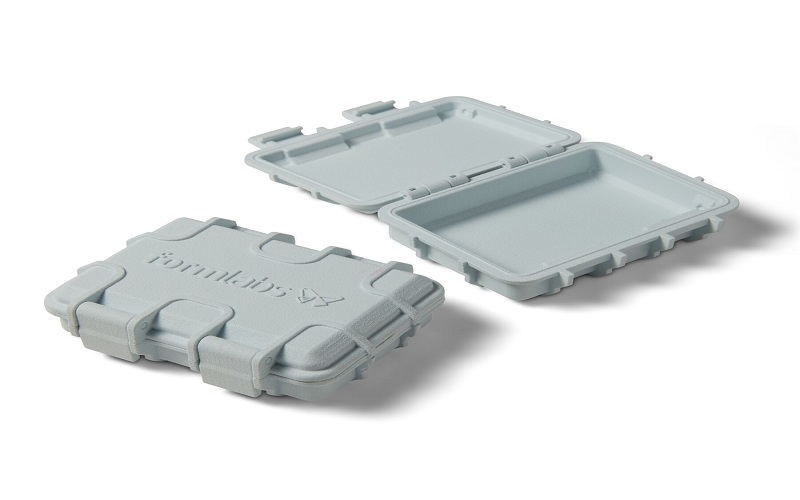
Other Nylons
Nylon 46 (PA46), Nylon 610, Nylon 612, and aromatic nylon are specialized types within the nylon family, each with unique properties.
Nylon 46, with its exceptional high-temperature resistance and mechanical strength, is widely used in high-performance engineering applications such as automotive engine components and high-temperature electrical parts.
Nylon 610 and 612, known for low moisture absorption and good chemical stability, are ideal for precision industrial components, tubing, and cable sheathing in humid environments.
Aromatic nylons, such as Kevlar and Nomex, offer ultra-high strength and heat resistance, making them suitable for bulletproof materials, aerospace composites, and fire-resistant fabrics to meet extreme conditions.
These nylon types significantly expand the application scope of nylon materials, driving advancements in high-performance materials.
Modification Of Nylon Materials
Due to the strong polarity of nylon (PA), it exhibits high moisture absorption and poor dimensional stability, but these shortcomings can be effectively addressed through modification techniques.
Glass fiber-reinforced nylon, incorporating 10%-40% glass fibers, significantly enhances tensile strength, rigidity, and heat resistance, making it ideal for automotive components and mechanical structures.
Flame-retardant nylon, with the addition of flame retardants, meets stringent fire safety standards such as UL94 V-0, and is widely used in circuit board housings and connectors in the electronics industry to ensure safety in high-temperature environments.
However, most flame retardants decompose at high temperatures, releasing acidic substances that can corrode metal, necessitating hard chromium plating for plasticizing components (such as screws, check valves, rings, washers, and flanges) to improve corrosion resistance.
Transparent nylon offers excellent tensile strength, impact resistance, rigidity, abrasion resistance, chemical resistance, and high light transmittance, comparable to optical glass.
During processing, the barrel temperature must be strictly controlled between 300-315°C; excessively high melt temperatures can cause degradation and discoloration, while temperatures too low may impair transparency due to poor plasticization.
These modification techniques significantly enhance nylon’s performance, enabling it to meet a wide range of application requirements.
Applications of Nylon Products
Textiles and Clothing
Nylon fibers are celebrated for their exceptional strength, outstanding abrasion resistance, and elasticity, combined with excellent dyeability and a soft texture.
These qualities make them ideal for producing a wide range of nylon clothing, including nylon stockings, sportswear, outdoor apparel (such as jackets), ropes, and fishing nets, catering to both fashion and functional needs with durability and comfort.
Automotive Industry
Nylon, particularly glass fiber-reinforced nylon, offers high strength, lightweight properties, and excellent heat resistance, making it an effective substitute for metal components.
It is commonly used in under-hood parts (e.g., intake manifolds and oil pans), structural elements, and interior components, contributing to lightweight vehicle designs that enhance fuel efficiency and durability.
Electronics and Electrical
Nylon’s superior electrical insulation and flame-retardant properties (especially in flame-retardant variants), coupled with robust mechanical strength and chemical resistance, make it ideal for manufacturing circuit board housings, connectors, switches, and cable sheaths.
These electrical connectors applications ensure the safety and reliability of electronic devices in high-temperature or humid environments.
Medical and Consumer Goods
Certain nylons, such as Nylon 11 and Nylon 12, offer excellent biocompatibility and chemical resistance, making them suitable for medical applications, while their durability and moldability benefit consumer products.
In the medical field, they are used for catheters, surgical sutures, and prosthetic components; in consumer goods, they are found in toothbrush handles, sports equipment, and durable packaging materials.
Industrial Products
Nylon’s high strength, wear resistance, and self-lubricating properties make it exceptionally well-suited for demanding industrial applications, particularly in high-load and high-friction environments.
It is widely used in manufacturing gears, bearings, pulleys, pipes, and conveyor belt components, supporting machinery, industrial automation, and fluid transfer systems with reliability and longevity.
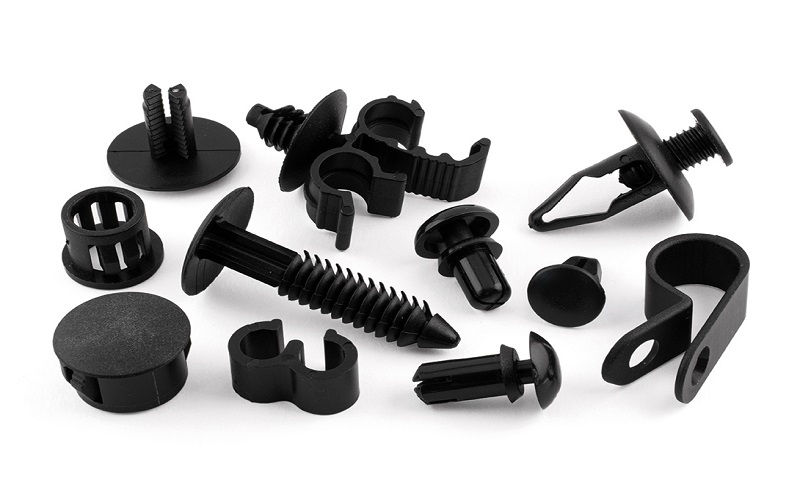
Which Nylon Type Is Used For Injection Molding?
Although there are many types of nylon, in plastic injection molding,Nylon 6 and Nylon 66 are the two most commonly used materials.
Nylon 6, with its excellent wear resistance and electrical insulation properties, is widely used in automotive interiors and engine components, electronic and electrical components, household items, and other industrial applications such as pumps and valves.
Meanwhile, PA66 is particularly suited for manufacturing high-performance engineering components that require high mechanical strength and heat resistance, high-temperature automotive parts, heavy-load electrical components, and precision machinery components.
Compared to other materials, nylon injection molding products offer lighter weight, better durability, and lower cost, making them the preferred choice in the plastic injection molding companies.
However, due to the strong hygroscopic nature of nylon’s amide groups, thorough drying is necessary before use to ensure the quality of the molding.
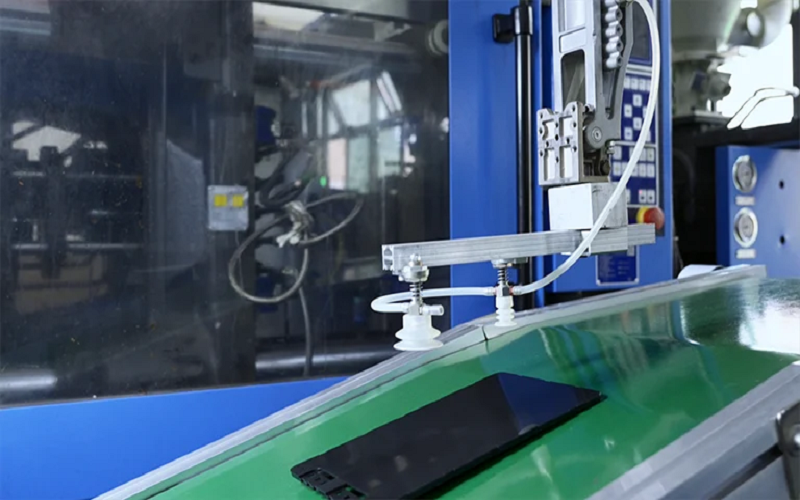
Environmental Impact Of Nylon Plastics
While nylon offers many desirable properties, its environmental impact is a growing concern. The production of nylon relies on many chemicals and generates significant emissions, contributing to pollution and resource depletion.
Nylon fibers are non-biodegradable and can persist in the environment for hundreds of years, adding to the problem of plastic pollution.
However, the industry is making strides toward sustainability by developing bio-based nylon, which is derived from renewable plant materials and has a reduced environmental footprint compared to traditional nylon.
Additionally, recycling technologies are being advanced to recover nylon fibers from used products and reprocess them into new materials, helping to mitigate the environmental impact of nylon production and disposal.
Addressing these sustainability challenges is essential for ensuring that nylon remains a responsible choice for future materials and applications.
Summary
Nylon, as a versatile synthetic polyamide material, stands out for its exceptional strength, wear resistance, chemical resistance, and processability, demonstrating wide-ranging applications in textiles, automotive, electronics, medical, and industrial fields.
Through an in-depth exploration of types such as Nylon 6, Nylon 66, Nylon 11, Nylon 12, and their modification techniques, the diversity in their performance and uses becomes evident, providing significant support for modern technology and industrial development.
Although nylon faces limitations such as moisture absorption and thermal stability, these drawbacks have been notably mitigated through technologies like glass fiber reinforcement, flame-retardant modification, and nanocomposites.
With ongoing technological advancements, nylon is poised to play an even greater role in lightweight, high-performance, and environmentally friendly applications, continually driving progress at the forefront of materials science.
